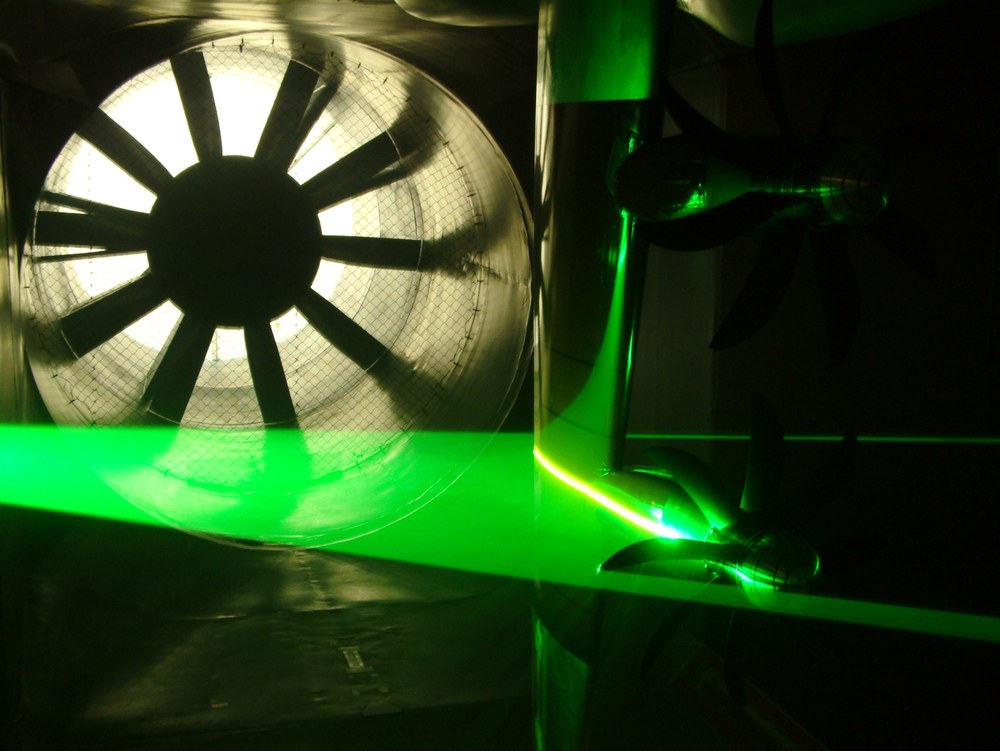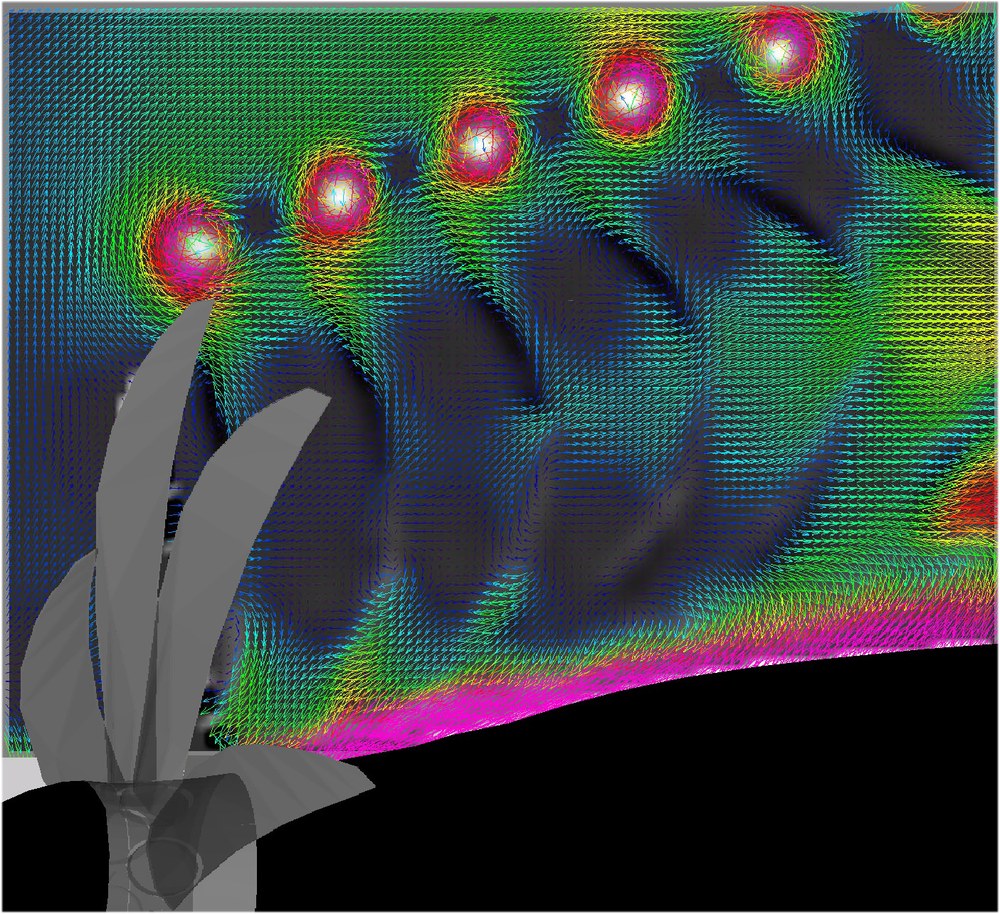Particle Image Velocimetry (PIV)
Particle Image Velocimetry is a state-of-the-art non-intrusive flow measurement technique. Small tracer particles advected by the flow are illuminated twice by very short pulses of a laser light sheet defining the measurement plane. Digital optical sensors capture the light scattered by the particles. Employing image analysis techniques instantaneous velocity vector fields are obtained in high spatial and temporal resolution.
The principle of the PIV measurement technique relies on the physical definition of velocity as a differential quotient. The trajectory of many tracer particles which follow the flow faithfully can be captured with a CCD- or CMOS-camera by illuminating a plane in the flow with two very short light pulses (few nanoseconds) within a time difference of a few microseconds. The two particle images captured at time t and t’ are stored on two frames of the CCD- or CMOS- sensor.
This allows to cross-correlate the two particle image distributions in small interrogation areas in order to determine their displacement on many positions of the observation field locally. Using the image magnification factor this method enables the measurement of typically more than 10,000 instantaneous velocity vectors for each double-image of the tracer particles inside the light sheet plane. Extending the PIV system to a stereoscopic camera set-up it is possible to determine all three components of the velocity vectors in the plane of the flow field instantaneously.
Nowadays PIV is used in microscale and in planes of more than 3 m² and in flows with velocities between a few mm/s and up to a km/sec. DLR has applied the PIV technique in industrial wind tunnels for e.g. high-lift applications, wake vortex studies, rotor/ propeller blades or in transonic flows on rolling delta wings.
The main interest of today’s research in fluid mechanics is more and more directed to problems where unsteady and separated flows are predominant. For investigations of flow fields with pronounced spatial structures and/or rapid temporal or spatial changes (transition from laminar to turbulent flow, coherent structures, pitching airfoils in transonic flows with shocks, rotors, test facilities with short run time, etc.) new experimental techniques, such as PIV are required which allow to capture the flow velocity of large flow fields instantaneously.
An important feature of PIV is that for the first time, a reliable basis of experimental flow field data is provided for direct comparison with numerical calculations and hence, for validation of computer codes. During the last years an increasing number of scientists have started to utilize the PIV technique to investigate the instantaneous structure of velocity fields in various areas of fluid mechanics.
Fields of application
- Characterisation of plumes from hot- and cold-gas thrusters orbital thrusters
- Plume implingement: forces / moments / heatloads
- Contamination analysis
- Interaction of highly underexpanded, clustered plumes
- Thermal vacuum chamber for functional component testing
- Outgassing analysis
- High lift flows
- Propeller flows
- Transsonic flows
- Boundary layers


General facts
- Location at DLR Göttingen
- Inauguration in 2004
- Method: Particle Image Velocimetry (PIV), non-intrusive optical method for measuring 2C- or 3C- (Stereo PIV) instantaneous velocity vector fields in a plane of the flow by means of pulsed laser light, cameras and a large number of tracer particles at low Stokes-numbers
Technical data
- 4 x 400 mJ Nd:YAG Double pulse laser (partly with pulse separation option) at lambda = 532 nm
- 8 x sCMOS global shutter double-frame cameras with 5.6 Mpx
- 5 x Particle generators and impactors delivering an aerosol with Ø ~ 1 µm
- 2 x Programable sequencer for generation TTL-signals at 16 channels
- 2 x Photron APX-RS 1 Mpx high-speed 3 kHz frame rate
- 8 x RAID 6 acquisition PCs, evaluation cluster and 10 GigE-NAS
- mobile PIV measurement system
Project highlights
- European Windtunnel Association - EWA
- PivNet 2
- AVERT
- FAR-Wake
- SAMURAI – Synergy of advanced measurement techniques for unsteady and high Reynolds number aerodynamic investigations
Aim: Investigation of high-lift-configurations with propeller integration in wind tunnels andreal aircraft engine flows during a A320 ground test using combined optical and acoustical field measurement techniques - VICTORIA - (Virtual Aircraft Technology Integration Platform, DLR)
Aim: Generation of a highly resolved, 3-dimensional velocity vector field data-set of turbulent boundary layers undergoing adverse pressure gradients at high Reynolds numbers - JERONIMO - JEt noise of high bypass RatiO eNgine: Installation, advanced Modelling and mitigatiOn
Aim: Investigation of aero-acoustic installation effects of aircraft engines by simulations, acoustic array- and flow field measurements (using Stereo PIV)
Cooperations
- Office National d'Etudes et de Recherches Aérospatiales (ONERA)
- Deutsch-Niederländische Windkanäle (DNW)
- Uni BW München
- TU Delft
- LaVision GmbH
- MPI –DS Göttingen
Literature
- Raffel M, Willert CE, Wereley ST, Kompenhans J (2007) Particle Image Velocimetry: A Practical Guide, 2nd edn. Springer, Berlin
- Westweel J, Elsinga GE, Adrian RJ (2013) Particle image velocimetry for complex and turbulent flows. Annu Rev Fluid Mech 45:409-43
